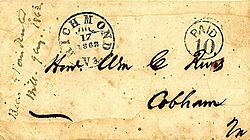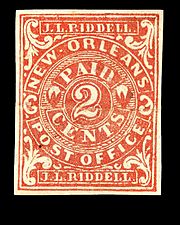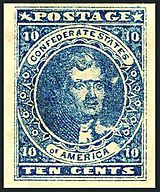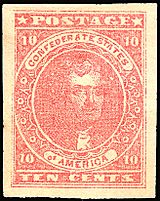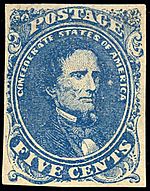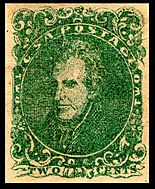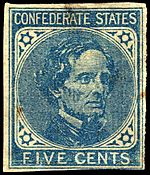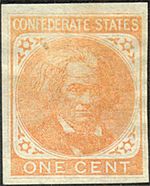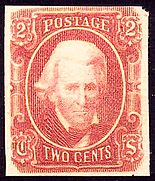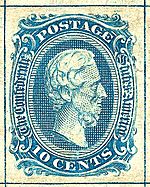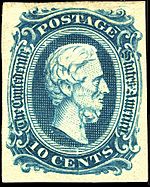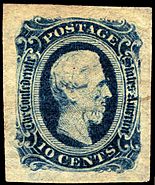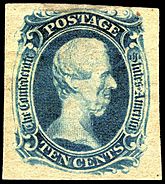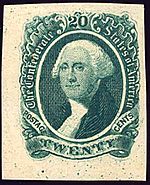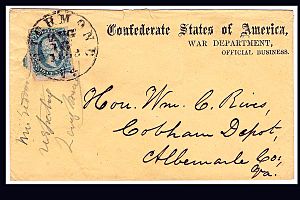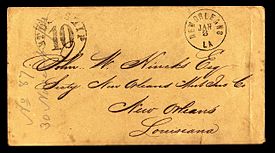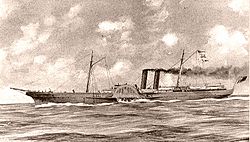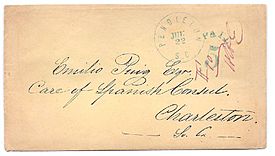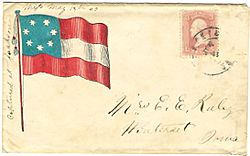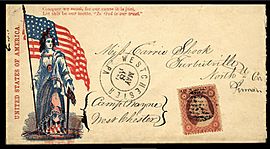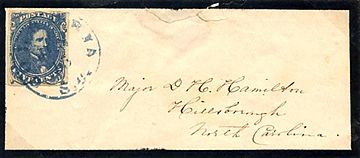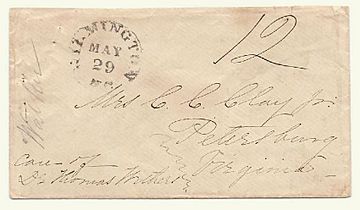Postage stamps and postal history of the Confederate States facts for kids
The postage stamps and postal system of the Confederate States of America helped carry mail during a short but important time in American history. This was when several Southern states decided to leave the United States and form their own country.
Even before the American Civil War officially started in April 1861, the Confederacy was already planning its own postal service. The Confederate Post Office was set up in February 1861. For a few weeks, the old U.S. Post Office still handled mail in these states. But by June 1, 1861, the Confederate Post Office took over. Its big job was to create new postage stamps and deliver mail to its citizens during the war.
The Confederate government wanted its postal service to pay for itself. Jefferson Davis, the President of the Confederacy, chose John Henninger Reagan to lead the new Post Office Department. Reagan did a great job, and the Confederate Post Office worked well throughout the entire Civil War.
Contents
How the Confederate Mail System Started
For about seven weeks at the beginning of the Civil War, the U.S. Post Office still delivered mail in the Southern states. If a letter was sent from a Confederate state during this time but used a U.S. stamp, it's called 'Confederate State Usage of U.S. Stamps'.
After this, private companies sometimes carried mail across the battle lines. Companies like Adams Express tried to keep mail moving. But the U.S. Post Office soon stopped this. After August 1861, mail between the North and South usually had to be sent by Flag of Truce. This was a special way to send mail through official exchange points.
Some mail was also smuggled in and out by ships called blockade runners. These ships tried to sneak past the Union Navy. Because the Confederate post offices only existed for a few years, and many records were lost, we learn a lot about them from old envelopes (called covers) that survived.
John H. Reagan and the Confederate Post Office
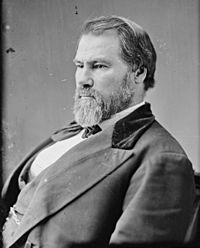
Confederate Postmaster General
One of the first big steps in setting up the Confederate Post Office was when Jefferson Davis appointed John H. Reagan as Postmaster General in 1861. Reagan was a congressman from Texas. He became a close friend of President Davis and was the only Postmaster General the Confederacy ever had.
Reagan was very clever in getting the new postal service ready. He even sent someone to Washington, D.C. to ask U.S. Post Office workers to come work for the Confederacy. Many of them did, bringing important records with them! One historian said Reagan "stole the U.S. Post Office." He was a very good leader, and his department was one of the few that worked well during the war.
The Confederate Post Office set new, higher rates for mail. For example, a letter traveling less than 500 miles cost 5 cents, and more than 500 miles cost 10 cents. Later, both rates became 10 cents. There was also a 40-cent rate for mail going across the Mississippi River because it was hard to get mail through the Union blockade there.
At the start of the war, Union blockades made it hard for the South to get supplies like paper and stamps. This meant postmasters often had to find their own ways to handle mail.
Since official stamps weren't ready by June 1861, postmasters often just took cash payment and stamped "PAID" on the envelope. Some postmasters, especially in bigger cities, created their own temporary stamps, called Postmaster's provisionals. These could be pre-stamped envelopes or stamps made by local printers. Today, some of these temporary stamps are very rare and valuable.
Confederate Postage Stamps
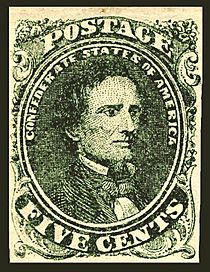
1st Confederate stamp
Issue of 1861
Within a month of becoming Postmaster General, Reagan started looking for companies to print Confederate stamps. Even though companies from the North offered bids, the contract went to a Southern company called Hoyer & Ludwig in Richmond. Their stamps weren't as fancy as the U.S. ones, but they did a good job with what they had.
The first Confederate stamps came out in October 1861. The very first stamp showed Jefferson Davis. This was a big change from the U.S. Post Office, which only put pictures of people who had passed away on their stamps.
Temporary Stamps (Provisional Stamps)
For five months, while the Confederate Post Office was getting its official stamps ready, local postmasters had to come up with their own solutions. They used different ways to show that postage was paid. This included making their own sticky stamps or just writing "Paid" on the letters. These temporary stamps and pre-paid envelopes are called 'Postmaster Provisionals' because they were used provisionally (temporarily) until the official stamps arrived.
Sometimes, even after official stamps were available, post offices would run out and go back to using these provisional stamps or hand-stamps. There are many different types of provisional stamps from various towns across the Confederacy. They are sometimes called 'locals' because they were only meant to be used in the town where they were issued.
Official Postage Stamps
The Confederate States of America only existed for four years, so it issued a small number of postage stamps—nine main types in total. Different companies printed these stamps using various methods like lithography (like printing from a stone), typography (like using movable type), and line-engraving (etching lines into metal). The first official stamps were released on October 16, 1861.
- The first Confederate stamp (1861) was a 5-cent green stamp showing Jefferson Davis. It was printed by Hoyer and Ludwig in Richmond. Most Confederate stamps were imperforate, meaning they didn't have little holes between them, so people had to cut them apart with scissors. This stamp was later reprinted in blue in 1862.
- A 10-cent blue stamp with Thomas Jefferson also came out in 1861. It was printed by Hoyer & Ludwig and later by J. T. Paterson & Co. The image of Jefferson was copied from a U.S. stamp. Paterson added tiny "secret marks" to their stamps to tell them apart. This stamp was mainly used for the 10-cent rate after July 1, 1862. It was also reprinted in a rare rose color in 1862.
- In 1862, a 2-cent green stamp of Andrew Jackson was issued, also imperforate. This was the last stamp printed using lithography by the Confederate Post Office.
- Also in 1862, a new 5-cent stamp of Davis was made using typography (a different printing method). A British company, De La Rue, printed 12 million of these stamps and sent them to the Confederacy, along with printing plates and paper. More than 36 million of these 5-cent Davis stamps were later printed by Archer & Daly in Richmond. When they ran out of the English paper, their later stamps looked rougher.
- De La Rue also printed a 1-cent orange stamp showing John C. Calhoun. The Confederate Post office planned to lower the drop-letter rate to one cent, but this didn't happen, so the 1-cent stamp was never used.
- In 1863, a new 2-cent Jackson stamp appeared, printed in pale red and later brown-red. All stamps after this one were made using line-engraving.
- Also in 1863, a 10-cent stamp with Jefferson Davis in blue was released. There are four similar designs of these 10-cent engraved stamps.
- One easy-to-spot 10-cent stamp has the word "TEN" written out. It was printed on soft paper and came in dark-blue to gray-blue colors.
- Another rare 10-cent stamp has straight lines around the design. These "frame-line" stamps are very rare and valuable today.
- Type I and Type II 10-cent stamps are similar and were also printed by Archer & Daly. A small number of these were perforated (had holes) in 1864, but many fakes exist.
- A 20-cent stamp with George Washington also appeared in 1863. This stamp was not used much, so genuine used copies are worth a lot more than unused ones.
Confederate Mail Envelopes (Covers)
Many Confederate covers (stamped and addressed envelopes) survived the American Civil War. Historians and collectors love these because they tell us a lot about the past. The war separated families and friends, so people wrote many more letters, especially to soldiers. Soldiers often asked their families to write back frequently.
Christian charity groups sometimes gave soldiers pens, paper, and envelopes because soldiers rarely had a chance to buy these things. The different types of mail from this time give us a great look into Civil War history.
Special types of covers include:
- Letters to and from soldiers.
- Patriotic covers with designs showing loyalty.
- Prisoner-of-war covers from soldiers in prison camps.
- Flag of Truce mail and mail sent through enemy lines.
- Mail carried by blockade runners to and from Europe.
Even though official records are often missing, these covers, with their addresses, postmarks, and special markings, help historians understand the postal history of the Civil War. Some fake covers were made later, so experts have to check if they are real. For example, the Confederate Post Office never used fancy cancellations (designs stamped over the stamp), so if you see one, it's probably fake.
Prisoner of War Mail
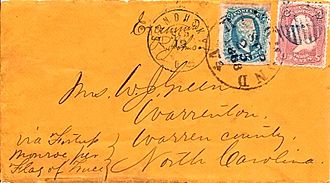
During the Civil War, a huge number of soldiers were captured and held in prison camps. At first, the U.S. government didn't recognize the Confederacy and refused to set up a system for exchanging prisoners or mail. But by mid-1862, so many prisoners were held that they agreed to a "Prisoner exchange cartel." This helped empty the prisons for a while.
However, as the war continued, the U.S. government stopped these exchanges in June 1863. Mail exchanges then resumed a month later using the Flag of Truce system.
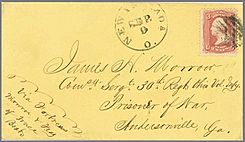
For Flag-of-Truce mail, a letter had to be put in an unsealed envelope with the address and postage for the other side. This was then placed inside a second, outer envelope. The outer envelope was sent to an exchange point, like City Point, Virginia (for mail going North to South) or Fortress Monroe, Virginia (for mail going South to North). At the exchange point, the outer envelope was removed, and the inner letter was checked by officials. Then, it was sealed and sent on its way.
Sometimes, people didn't follow the two-envelope rule. So, you can find examples where both U.S. and Confederate stamps were put on the same letter. These are called dual-use postage covers. Prison mail often had the prisoner's name, rank, and company written on it. The word "Examined" (often handwritten) meant that prison officials had checked the letter.
Mail to and from military prisons is a very interesting part of Civil War postal history. Letters sent to prisons are usually much rarer than letters sent from them. Also, because the South had paper shortages, mail from Confederate prisons is rarer than mail from Union prisons.
Blockade Mail
At the start of the Civil War, the Confederacy desperately needed to send and receive important letters, especially to suppliers overseas. On April 19, 1861, Abraham Lincoln announced a blockade along the entire Confederate coastline. This was to stop supplies from reaching the South and to prevent them from communicating by mail with other countries.
The Union Navy used hundreds of ships to patrol the 3,500 miles of coastline. This blockade was a huge part of the Union's victory. By the end of the war, the Union Navy had captured or destroyed many blockade runners. The blockade greatly reduced the South's income from cotton exports and stopped much of its mail.
In response, British investors, who were interested in the cotton trade, built special, fast steamships. These ships were smaller and lighter, often reaching speeds of up to 17 knots, which helped them escape Union ships. They usually carried small, light cargo, which often included mail.
Blockade Runners
Getting Confederate mail in and out of the country was a big challenge. At first, it was easier to get a ship through the Union blockade. But as the war went on, more Union ships patrolled, and their crews became better at catching blockade runners.
To avoid being seen, blockade runners often tried to make their runs at night, especially when there was no moon. Many ships were painted dark gray to blend in with the night sea, earning them the nickname Greyhounds. Some even burned special coal that produced less smoke. However, as the war continued, it became much harder to get through, and many ships were captured or destroyed. Their cargo and mail often never reached their destination.
If a blockade runner was captured, its cargo was given to the captain and crew of the capturing Union ship as a reward. Mail was also taken and sometimes used as evidence. This is why some letters meant for the Confederacy never received Confederate postmarks.
Famous blockade runners included the SS Syren, which made 33 successful trips, and the Alice, which made 24. Most blockade runners probably carried mail, as the Confederacy desperately needed supplies, and these deals were made through letters. Today, Confederate blockade covers are highly valued by collectors and historians because they are like time capsules, confirming the existence of people, ships, and post offices from that era.
The main places where mail from Europe was transferred were Nassau in the Bahamas, Bermuda, and Cuba. Ships would drop off mail there, and a forwarding agent would prepare it for transfer to a blockade runner. These agents often put their own markings on the envelopes. If lucky, the mail would then reach Confederate ports like New Orleans, Charleston, or Wilmington, where it entered the regular Confederate mail system.
The captain of a blockade runner earned a small fee for each letter delivered, but their main income came from the cargo. Most blockade runners only made about four successful trips before being caught or destroyed. Charleston and Wilmington were very busy ports for blockade runners. New Orleans was also important because the lower Mississippi River was blockaded, separating the Western Confederate states. Many blockade covers have postmarks from these busy ports.
Patriotic Covers
During the Civil War, people on both sides felt very strongly about their cause. You can see these feelings on special envelopes called Patriotic Covers. Citizens, especially those with family fighting or who had died in battle, showed their loyalty with envelopes decorated with flags, portraits, slogans, and symbols like Liberty.
This was very common in the North, where many printers made a wide variety of these envelopes. In the South, it was different. The South was more agricultural and had fewer printers and less industry. So, Confederate patriotic covers are much rarer and more valuable today.
Adversity Covers
Because of the Union blockade, the South had trouble getting basic supplies, including paper. Envelopes and writing paper were hard to find. People would reuse old paper, envelopes, bags, and even wallpaper to make new envelopes. These are called adversity covers by collectors.
Mourning Covers
Mourning covers are also collected. These envelopes show sympathy for a sad event, most often the death of a loved one during the Civil War. Many families lost members in the four-year war. Letters of sympathy were often sent between family and friends. These covers often have special markings, usually drawn by hand. The most common marking is a symbolic black border around the edge of the envelope. Because so many men died, black-bordered envelopes became common in both Union and Confederate mail.
Manuscript Covers
Manuscript covers are envelopes where the word "Paid" or the amount of postage due was written by hand with a pen. Sometimes, handwritten marks appear with hand-stamps or even with postage stamps. If a manuscript cover was carried by a blockade runner, it's also called a blockade cover, and so forth for other types like patriotic covers.
Images for kids
-
Adams Express Company postmark, with 'Paid 10' handstamp, 1861
-
CSA Stamp on cover from Richmond, Va.
-
Old Point Comfort, Fortress Monroe, Virginia, 1864
-
1862 Washington, D.C. cover with 3c Washington 1861 Issue to Enfield Center, N.H. Red Patriotic Eleventh New Hampshire Regiment.
-
Confederate blockade cover, with Pendleton S.C. 'Jul 22' postmark, carried aboard the blockade runner Nuestra Senora de Regla, by Emilio Puiz, when ship was seized on November 29, 1861. Cover used as evidence in court. Hand-stamped,'Paid 5', court docket of 'HHE'
-
Confederate POW cover mailed from Washington, D.C. on May 22, 1865, (after Lee's surrender), Class B. Addressed to Thomas C. Trombs, Point Lookout, MD. Examined and manuscript marking by censor at Fredericksburg, Virginia, May 19, 1865.
-
Mail from Virginia bearing a manuscript Virginia town, "Gravelton, Va" with postmaster's signature."H. A. Camp PM" ties the CSA stamp to cover, dated "Feb 27, 1865". Manuscript "Gen Ould Commissioner Exchange Richmond, Va" at upper left. Cover sent via Fortress Monroe Va with Old Point Comfort, Va double-ring Postmark, Mar 25, 1865, and the US stamp tied with cork cancel.
-
Prisoner letter from Fort Delaware, October 26, 1864
-
Cover is postmarked Delaware City, Delaware, August 9, 1864, bears a Federal prison mark, confirming examination of the prisoner's letter. Cancel for stamp is a concentric circle killer.
-
Blockade cover, New Orleans, March 18, 1863
-
Johnson's Island POW camp for Confederate Officers, 1865
-
Flag of Truce cover, Old Point Comfort (Fortress Monroe transfer point), 1863
-
T.Jefferson, 1861 Confederate 10-cent Thomas Jefferson. Postmark, Richmond, Virginia, November 11, 1861, circular date stamp on eleven-star flag patriotic envelope to Oxford, Georgia.
-
Point Look Out, MD, 1864
-
Winslow Homer, Prisoners from the Front, 1866, Metropolitan Museum of Art


